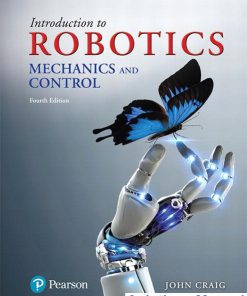Basic Robotics 1st Edition Dinwiddie Solutions Manual
$50.00 Original price was: $50.00.$26.50Current price is: $26.50.
Basic Robotics 1st Edition Dinwiddie Solutions Manual.
This is completed downloadable of Basic Robotics 1st Edition Dinwiddie Solutions Manual
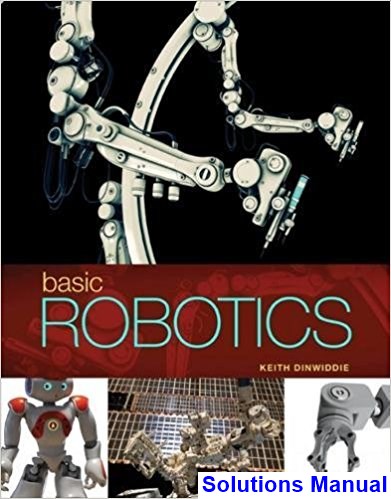
Product Details:
- ISBN-10 : 9781133950196
- ISBN-13 : 978-1133950196
- Author: Keith E. Dinwiddie
With no previous experience required, BASIC ROBOTICS walks readers step by step through the fundamentals of the industrial robot system. It begins with an exploration of the fascinating technological history that led to the modern robot, starting with events from Before the Common Era and ending with a glimpse of what the robots of tomorrow might become. From there the book explores safety, various parts of the robot, tooling, power transmission systems, the basics of programming, troubleshooting, maintenance, and much more. Engaging photos highlight various robotic systems and their parts, while stories of real-world events bring text concepts to life. This innovative First Edition incorporates many of the initiatives of STEM and is the culmination of lessons learned from the author’s years of teaching robotics in various formats–from the traditional classroom to the industrial production floor with systems ranging from the LEGO Mindstorms NXT to the FANUC robot.
Table of Content:
1. HISTORY OF ROBOTICS. Timeline of Events. Key Events in the History of Robotics. What is a Robot? Why Use a Robot? Top Down vs. Bottom Up. AI and the Future of Robots.
2. SAFETY. Robots Require Respect. Danger Zones. Guarding. Safety Devices. Electricity and You! Handling Emergencies.
3. COMPONENTS OF THE ROBOT. Power Supply. Controller/Logic Function. Teach Pendant/Interface. Manipulator, Degrees of Freedom (DOF), and Axis Numbering. Base Types.
4. CLASSIFICATION OF ROBOTS. How Do We Classify Robots? Power Source. Geometry of Work Envelope. Drive Systems: Classification and Operation. International Standards Organization (ISO) Classification.
5. END-OF-ARM TOOLING. What is End-of-Arm Tooling (EOAT)? Types of Tooling Available. Grippers. Gripper Force. Payload. Other Grippers. Other Types of End-of-Arm Tooling. Multiple Tooling. Positioning of Tooling.
6. SENSORS AND VISION. Limit Switches. Proximity. Tactile and Impact. Position. Sound. Vision Systems.
7. PERIPHERAL SYSTEMS. What is a Peripheral System? Safety Systems. Positioners. End-of-Arm Tooling Peripheral Systems. What is a Work Cell? Nonindustrial Peripherals. System Communication.
8. ROBOT OPERATION. Before Powering the Robot Up. Powering the System Up. Moving the Robot Manually. What Do I Want the Robot to Do? How Do I Know What the Robot Will Do? So, I Crashed the Robot Now What?
9. PROGRAMMING AND FILE MANAGEMENT. Programming Language Evolution. Planning. Subroutines. Writing the Program. Testing and Verifying. Normal Operation. File Maintenance.
10. TROUBLESHOOTING. What is Troubleshooting? Analyzing the Problem. Gathering Information. Additional Resources for Information. Finding a Solution. If at First You Do Not Succeed .
11. REPAIRING THE ROBOT. Preventive Maintenance. Precautions to Take Before You Begin Repairs. Repair Tips. Parts Swapping vs. Fixing the Problem. Precautions Before Running the Robot. What to Do if the Robot is Still Broke. The Robot is Running, Now What?
12. JUSTIFYING THE USE OF A ROBOT. Robot vs. Human Labor. Return on Investment (ROI). Precision and Quality. Use of Consumables. Hazardous Environments. Nonindustrial Justifications. Glossary. Bibliography.
Index.
People Also Search:
basic robotics dinwiddie
basic robotics 1st edition dinwiddie
basic robotics
basic robotics 1st edition download scribd
basic robotics 1st edition
basic robotics keith dinwiddie pdf
basic robotics 1st edition solution manual download pdf
Instant download after Payment is complete
You may also like…
Solutions Manual
Understanding Basic Statistics 8th Edition Brase Solutions Manual
Solutions Manual
Solutions Manual
Basic Business Statistics 13th Edition Berenson Solutions Manual
Solutions Manual
Basic College Mathematics 10th Edition Lial Solutions Manual
Calculus and Mathematics
Basic College Mathematics 2nd Edition Miller Solutions Manual
Canadian
Basic College Mathematics An Applied Approach Canadian 1st Edition Aufmann Solutions Manual
Calculus and Mathematics
Basic College Mathematics 12th Edition Bittinger Solutions Manual
Solutions Manual
Related products
Solutions Manual
Accounting for Governmental and Nonprofit Entities 15th Edition Wilson Solutions Manual
Solutions Manual
Solutions Manual
Accounting Information Systems 10th Edition Hall Solutions Manual
Solutions Manual
Solutions Manual
Accounting Texts and Cases 13th Edition Anthony Solutions Manual
Solutions Manual
A+ Guide to IT Technical Support Hardware and Software 9th Edition Andrews Solutions Manual



